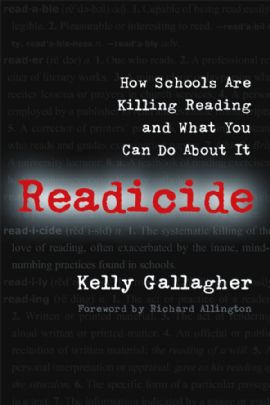Talking to kids jars me at times.
Yes, they say silly, sometimes inappropriate things and ask about my personal life a tad too often for my liking, but that’s not what really gets to me. What surprises me most is when students call reading “dumb” or “stupid,” stating that it is “a waste of [their] time.”
Normally it’s here that I start vehemently arguing for reading. I mean, I AM a future language arts teacher; who would I be if I didn’t argue for the importance of reading? I state the benefits and the feel of really falling into a good book. Though this sometimes works, it’s more often that my words fall on deaf ears, ears that have been forced to read not for fun but for academic purposes.
Ears that have been put through readicide.

Readicide by Kelly Gallagher was one of the professional development books I read this semester. I was blown away. In just 118 pages, Gallagher lays out the foundation for the readicide occurring across the nation today. Though he lays out numerous factors that have contributed to the decline (poverty, lack of resources, the rise of electronic entertainment industry), Gallagher calls for us to finally address the elephant in the room and point out the one powerhouse that has yet to be questioned: our schools.
Readicide : (n) The systematic killing of the love of reading, often exacerbated by the inane, mind-numbing practices found in schools.
Gallagher calls for teachers to “take a hard look at what we are doing to potential readers” (5). How do our practices match up with our desired results. Are we valuing certain areas over reading? Do we have the environment to support a book flood or are our student living in a desert? Kelly Gallagher suggests 4 major factors that are leading to the massive readicide in schools today:
- Schools value the development of test-takers more than they value the development of readers
- Schools are limiting authentic reading experiences
- Teachers are overteaching books
- Teachers are underteaching books
As readers move through the chapters, each one of these issues is addressed and solutions are presented for teachers to try out. One of the most interesting moments for me was the breakdown of how much students are actually reading in schools and on their own today. Though these statistics may be from a 2007 release, they are no doubt still relevant today:
- “The percentage of thirteen-year-olds who read for fun on a daily basis declined from 35 percent to 30 percent, and for seventeen-year-olds the decline was from 33 percent to 22 percent.
- On average, Americans ages fifteen to twenty-four spend almost two hours a day watching television, and only seven minutes of their leisure time on reading.
- Less than one-third of thirteen-year-olds are daily readers, a 14 percent decline from twenty years earlier.
- Nearly half of all Americans ages fifteen to twenty-four do not read books for pleasure” (41).
But what can we do to combat this? These numbers are staggering and, if I’m being honest, a little intimidating. How can we instill a love of reading that is not forced? Gallagher gives us several ideas, such as establishing a book flood through your classroom library, putting real-world, authentic texts in your classroom, and starting SSR (Silent Sustained Reading) in the school. Allowing students to engage in authentic reading takes away a big factor listed above that leads to readicide. Let students read what they are interested in. Don’t shut down their likes and dislikes, but instead provide ample reading material in various forms while allowing time to fall into the reading zone.
Another piece of Gallagher’s book that stuck with me was the “overteaching” section. In this, he argues for teachers to remember authentic reading practices and throw out the “chop-chop” curriculum (61). Gallagher calls this the “recipe for killing young readers”:
The Kill-a-Reader Casserole
Take one large novel. Dice into as many pieces as possible.
Douse with sticky notes.
Remove book from oven every five minutes and insert worksheets.
Add more sticky notes.
Baste until novel is unrecognizable, far beyond well done.
Serve in choppy, bite-size chunks (73).
We don’t need to dissect every single part of a novel; the kids take meaning for themselves without us butting in. Do we sometimes want to discuss what is happening? Of course. Discussion is rich and leads to better understanding. The problem becomes when discussion pervades the reading flow and students are never able to fully immerse themselves in the novel. Gallagher says we don’t need the 139 page study guides to walk us through the book; instead, we need our own minds and authentic life experiences.
Gallagher makes it clear that he is not calling for the classroom to become a free-for-all but is instead advocating to teach the reader more and the reading less. He advocates that we all find the “sweet spot” of instruction that doesn’t overteach or underteach material. We need to know our readers. We need to be open to change. Most importantly, we need to recognize that readicide is happening and move to change the status quo.

I really like this distinction: teach readers, not reading. I think he might have talked about this at NCTE too: be committed to teaching literacy, not literature. We become wedded to specific books or lesson plans rather than focusing on the broader set of skills, strategies, and habits our students need to be successful with any text.
LikeLike
Yes!! I love the “teach literacy not literature” thought. I think we all pull such different interpretations from text and learn in our way that it makes a single teaching of a text inadequate. Thank goodness for workshop method and choice. 🙂
LikeLike